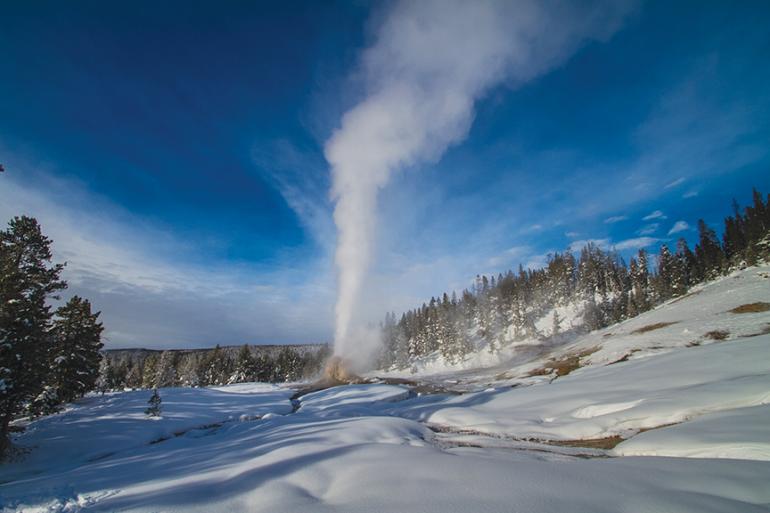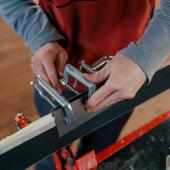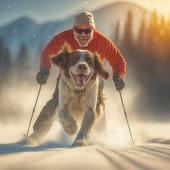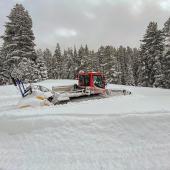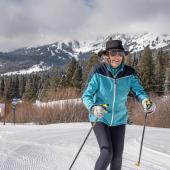All to Yourself
It was winter in Yellowstone National Park, and the elevated boardwalk gave us an unhindered view of the Upper Geyser Basin, home to Old Faithful, draped in its winter whites and sparkling in the sunshine. In every direction belching geysers, fumaroles, and colorful hot springs breathed life and color into the austere winter landscape. The largest concentration of Yellowstone’s 10,000 resided in the basin before us, and we stood there gawking with not another soul in sight. This was Yellowstone in winter—solitary, intense, and very quiet.
The Ghosts of Winters Past
It was incredible to think that despite our dearth of trail encounters, upward of 90,000 people visit the park in the winter. Many see the sights from a snow coach, and the snowmobile seems to be the self-propelled vehicle of choice—a trend that was started in 1963 when the first six snowmobiles entered the park. Restricted to the main roads and to a number limit, their impact is negligible to the skiing experience, leaving the backcountry for people who are prepared to trade a little sweat for their views and experience.
Promotion of Yellowstone as a winter resort started in the late 1880s, and ski travel had been common in the park a decade before that. The earliest skiers were an iniquitous bunch, poachers there to make a killing. Ungulates are vulnerable in winter and the poachers took full advantage of this, indiscriminately slaughtering bison and elk herds. Their criminal activity precipitated another generation of park ski pioneers—the United States Army.
Beginning in the mid 1880s, army ski patrols—with civilian scouts—worked in extreme winter conditions to staunch the killing over several decades. The army built a number of snowshoe cabins across the interior of the park to support longer patrols, but the poaching continued, and a late 19th century wildlife count registered no bison in the geyser areas. There were less than 50 thought to exist in the park.
The Roar of Silence
As we skied out of Old Faithful village in sunny, clear conditions, perfect for viewing the many natural wonders of the area. The ground was a patchwork of white and brown, a sea of snow melted back in places to reveal islands of steaming earth. Numerous hoof prints, flattened ground, and bison scat identified favored resting places of the numerous bison that again live here and for whom this warm habitat is critical to winter survival. When you weigh 1,800 pounds, the fragile and tenuous nature of the ground makes this a risky business.
Ignoring their role modeling, we went for the prudent (and legal) option, confining our skiing to the boardwalks. Boardwalks provide an interesting skiing surface. Usually smooth and low stress, occasional icy sections can add an unexpected but impressive level of excitement to an otherwise sedate ski tour. We found that an over-exaggerated snowplow in combination with light skis and two poles were mightily useful for maintaining control on a slippery downhill run toward a bubbling hot spring. The park's early skiers might have found it harder. Their “snowshoes” were 9-15 feet long, made from wood, and weighed upward of 10 pounds. They also restricted themselves to one long wooden pole.
The foliage was sparse in the geyser basin, reduced to isolated lodgepole pines punctuated by dead trees cauterized in the 1988 wildfires. Now they're misshapen, burnished steel sculptures reaching skywards, thrown into stark, sharp relief by the pallid winter backdrop.
In the surrounding hills, tracts of live trees survived the fire. We had skied there in the previous days, following meandering trail markers through stands of snow-laden lodgepole pine and Engelmann spruce, at times wading through thigh-deep powder. The eerie whisper of wind in the tree tops was often the only sound apart from the squeak of our skis, and the silence settled as thick as the snow, creating a numinous calm.
We found an elk carcass on the trail, a wolf kill judging by the surrounding tracks. The Nez Perce pack had resided in the area before disbanding in 2005, but a wolf sighting near Old Faithful the week before, and now a kill site, suggested there were still wolves in the vicinity.
We skied for several hours, pausing to gaze into azure pools, jewels in white-gold settings with names like Morning Glory, Gem, and Chromatic; past spurting geysers, through plumes of steam and bison herds toward Biscuit Basin. A coyote did a solitary break dance trying to trap prey burrowed beneath the snow. We watched a while, laughing at its antics, then turned back toward Old Faithful, the warmth of Snow Lodge, and the journey home.
As we wafted through the easy, groomed trails in easy terrain and feverishly worked on the challenging trails where route-finding skills are essential, my partner and I realized how seriously underutilized and underappreciated the Old Faithful Nordic ski area is. In our first three days of skiing in this winter playground, we encountered only 12 other trail users; and despite our best efforts and some long days, we had barely scratched the surface of the area's skiing. The blanket of snow had insulated Yellowstone for another winter, and even though the park belongs to everyone, it felt like it was all ours.

